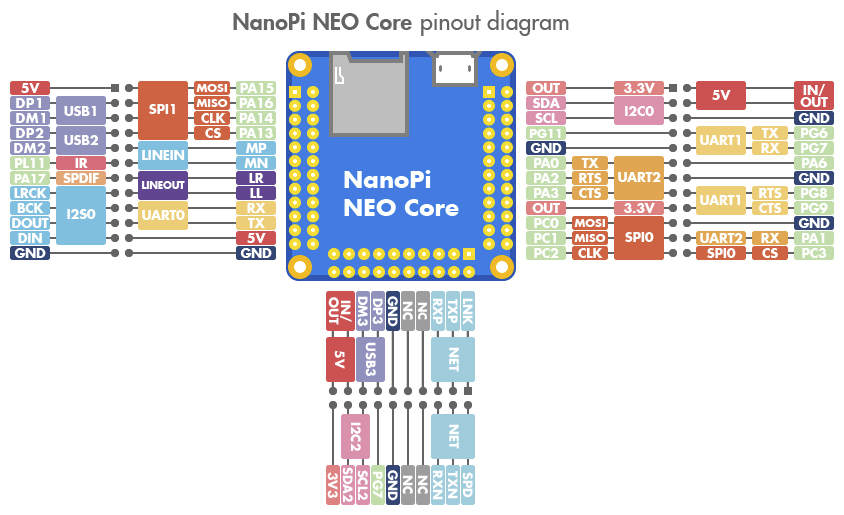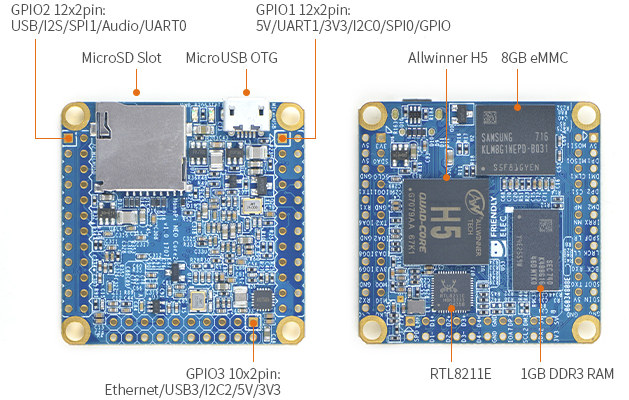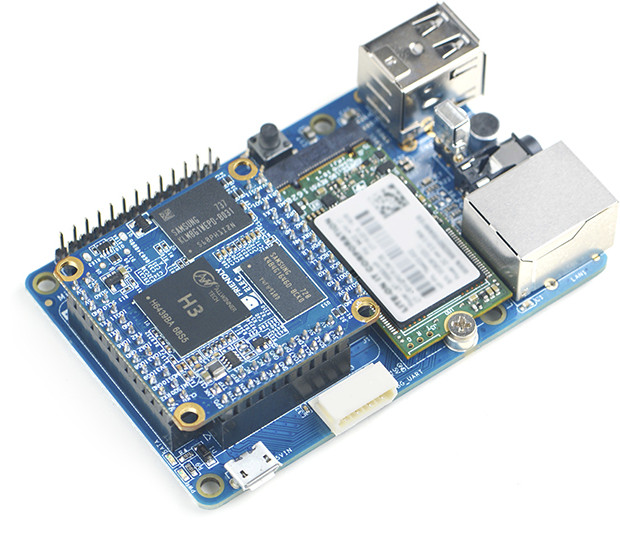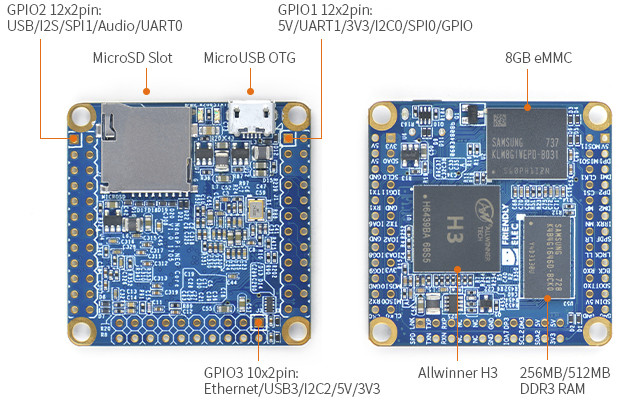FriendlyELEC has launched many cool NanoPi development boards such as NanoPi NEO2, NanoPi A64, or more recently NanoPi Duo based on Allwinner H- or A- series ARM processors, as well as some models based on Samsung/Nexcell or Amlogic SoC.
The company has now launched two other NanoPi products that are a bit different since they are systems-on-module – or could even be considered minimal development boards – with namely NanoPi NEO Core powered by Allwinner H3 quad core 32-bit processor, and NanoPi NEO Core2 based on Allwinner H5 quad core 64-but processor.
NanoPi NEO Core
Specifications:
- SoC – Allwinner H3 quad core ARM Cortex-A7 processor up to 1.2GHz with Mali-400MP GPU
- System Memory – 256MB or 512MB DDR3 RAM
- Storage – NC/8GB/16GB/32GB eMMC flash, micro SD slot
- USB – 1x micro USB OTG port also used for power input
- Expansion – 2x 2.54mm pitch 24-pin headers, 1x 2.54mm pitch 20-pin header exposing:
- Connectivity – 10/100M Ethernet
- USB – 3x USB Host port
- 4-pin debug serial port
- 4-pin audio input/output port
- UART, SPI, I2C, GPIO, IR etc…
- Power Supply – 5V/2A
- Dimensions – 40 x 40mm
- Temperature measuring range – -40 to 80

A Ubuntu Core Xenial image with Linux 4.14 is provided, and documentation can be found in the Wiki.
The board is sold for $7.99 with no flash and 256MB RAM, but a version with 512MB RAM and 8GB eMMC flash is also offered for $10 extra.
NanoPi NEO Core2
 The 64-bit version of the board has basically the same specifications, except for the different processor, more memory, and an extra Realtek RTL8211E Gigabit Ethernet transceiver:
The 64-bit version of the board has basically the same specifications, except for the different processor, more memory, and an extra Realtek RTL8211E Gigabit Ethernet transceiver:
- SoC – Allwinner H5 quad core ARM Cortex-A53 processor with a Mali-450MP GPU
- System Memory – 512MB or 1GB DDR3 RAM
- Storage – 8GB/16GB/32GB eMMC flash, micro SD slot
- USB – 1x micro USB OTG port also used for power input
- Expansion – 2x 2.54mm pitch 24-pin headers, 1x 2.54mm pitch 20-pin header exposing:
- Connectivity – Gigabit Ethernet via RTL8211E transceiver
- USB – 3x USB Host port
- 4-pin debug serial port
- 4-pin audio input/output port
- UART, SPI, I2C, GPIO, IR, etc…
- Misc – 2x LEDs for power and system status
- Power Supply – 5V/2A
- Dimensions – 40 x 40mm
- Temperature measuring range – -40 to 80
 Both NanoPi Core and Core2 modules appear to be pin-to-pin compatible. NanoPi NEO Core2 runs a different firmware image also based on Ubuntu Xenial with Linux 4.14, and more technical info is listed in the Wiki. I also suspect both boards are software compatible with NanoPi NEO / NEO2, so other firmware such as Armbian images may also run without modifications.
Both NanoPi Core and Core2 modules appear to be pin-to-pin compatible. NanoPi NEO Core2 runs a different firmware image also based on Ubuntu Xenial with Linux 4.14, and more technical info is listed in the Wiki. I also suspect both boards are software compatible with NanoPi NEO / NEO2, so other firmware such as Armbian images may also run without modifications.
FriendlyELEC does not offer a version without flash, and actually only one version is for sale now with 1GB/8GB configuration for $24.99.
Mini Shield for NanoPi NEO Core/Core2

You could wire your NEO Core(2) board yourself, if you want to get started quickly, or something that works out of the box with USB, Ethernet, and audio connectors, as well an M.2 slot, the Mini Shield is here to help with the following specs:
- Storage – 1x M.2 2242 SSD socket
- Connectivity – 1x Ethernet port
- USB – 2x USB Host
- Audio – audio input and 1 x audio output
- Expansion – 2x 13-pin GPIO header
- Debugging – 1x Serial debug port and
- Misc – 1x button, 1x IR receiver
- Dimensions – 85 x 56 mm (Raspberry Pi form factor, compatible with enclosures)
Mini Shield can be purchased as option for $10.99 extra on NanoPi NEO Core or Core2 product pages. It has its own Wiki page where you can find additional hardware details.

Jean-Luc started CNX Software in 2010 as a part-time endeavor, before quitting his job as a software engineering manager, and starting to write daily news, and reviews full time later in 2011.
Support CNX Software! Donate via cryptocurrencies, become a Patron on Patreon, or purchase goods on Amazon or Aliexpress





